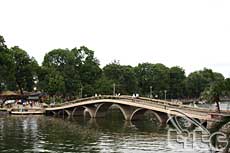Hanoi is an elegant city built on the right bank of the Red River. The twenty lakes which now circle and enhance the city have evolved, over the centuries, as the river has changed course and the land has been drained for habitation. Together the lakes and waterways combined with the pervasive French architecture give the City an almost European feel.
 Our hotel was French, but a modern sky scraper structure. This had its advantages, as the view from our 16th storey window was spectacular, looking down on to a causeway which separated the grand West Lake (a circumference of ten miles making it the biggest) and Truc Bach Lake. The Tran Quoc Pagoda, a Buddhist temple, is clearly visible standing on a small island at the edge of West Lake. This Temple was originally constructed in the sixth century and is the oldest in the city; it was moved from its original location on the Red River four hundred years ago. The lakes were to take on different personas even during just a three day visit. From serene and bright on our first day to shrouded in mist and cloud on the second day. Our third day was the most dramatic as an electrical storm balanced over the water throwing rapiers of light onto the darkened surface.
Our hotel was French, but a modern sky scraper structure. This had its advantages, as the view from our 16th storey window was spectacular, looking down on to a causeway which separated the grand West Lake (a circumference of ten miles making it the biggest) and Truc Bach Lake. The Tran Quoc Pagoda, a Buddhist temple, is clearly visible standing on a small island at the edge of West Lake. This Temple was originally constructed in the sixth century and is the oldest in the city; it was moved from its original location on the Red River four hundred years ago. The lakes were to take on different personas even during just a three day visit. From serene and bright on our first day to shrouded in mist and cloud on the second day. Our third day was the most dramatic as an electrical storm balanced over the water throwing rapiers of light onto the darkened surface.
A visit to the Old Quarter is a prerequisite to any other activities. Situated adjacent to Hoan Kiem Lake the narrow alleyways and streets, still named, in many instances, after the artisan or merchants who lived and worked in them, are busy, bustling places reflecting the original layout and architecture of yesteryear.
Many streets still adhere to the adage of all selling the same thing which was apparent as we wandered past, and into, shop after shop selling swathes of silk and silk clothing. This street is called Hang Dao, the "Dao" meaning flower or beautiful woman. There are many streets which have the word Hang as a precursor in its name reflecting that it belonged to a trade, the second word describing the trade such as "chao" (rice porridge) or "mam" (salted fish). Not many of the streets now sell their original products while others sell a mixture of everything. The only problem we had was that with so many streets having the same first word it was easy to get confused and lost.
It is not difficult, however, to find a place to eat, there are as many options available as there is stars in the sky and down one of the small back alleys in a cobbled courtyard we found "The Green Tangerine" offering a fusion of Vietnamese spices with French delicacies. The two storey terrace building, painted in the sunny colours of the Mediterranean (a common feature of this city) stood over the outdoor eating area and, as the electricity was off this day; most diners were taking advantage of the clement weather to eat in this secluded precinct.
After a good lunch we walked to the Women's Museum, this has been rated as one of the top tourist attractions of the city and for a mere 30,000 dong provides excellent value for an afternoon of interest. The Museum focuses on the contribution of women in Vietnam's Culture. It covers the traditional role of women as wives and mothers and showcases the many differences this role embraces, depending on the ethnic background of the woman within Vietnam. There are feature films of female street vendors who talk stoically about the long hours they work. There is also a level devoted to the heroic women who fought side by side with men in the Vietnam/America War, photographs and personal anecdotes, of their frequently short lives, bringing the women to life.
The beauty, charm and history of Hanoi made our trip one to remember. We will return.